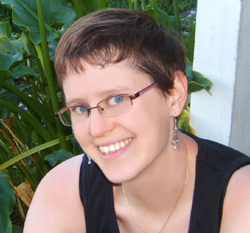Last week I began posting a series of interviews about inclusivity and exclusivity in fiction-that is, what groups of people are conspicuously underrepresented in fiction based on their race, sexual orientation, gender or gender identity, age, ethnicity, disability, or other factors; and why; and what can we do about it?
I started with this interview of Leah Bobet and followed up with a short post about the lack of female villains. Today’s post is an interview with Vylar Kaftan, who has described herself as a “queer white writer” and who has made inclusivity a particular mission in her work.
 LUC: A few years ago, I gather you spent about 5 hours putting together statistics on the characters in your fiction in terms of gender, race, sexual orientation, age, and class (readers: you can see Vylar’s results for all her characters and for her protagonists. Aliette de Bodard and Marshall Payne followed Vylar’s lead and reported their own results). I think it’s safe to say that in most categories, your numbers were much more diverse than the general run of English language fiction in North America and Europe. Were you satisfied with where you landed? Did anything change after you saw your results?
LUC: A few years ago, I gather you spent about 5 hours putting together statistics on the characters in your fiction in terms of gender, race, sexual orientation, age, and class (readers: you can see Vylar’s results for all her characters and for her protagonists. Aliette de Bodard and Marshall Payne followed Vylar’s lead and reported their own results). I think it’s safe to say that in most categories, your numbers were much more diverse than the general run of English language fiction in North America and Europe. Were you satisfied with where you landed? Did anything change after you saw your results?
VYLAR: I thought the results were fascinating, and I’m sure glad I did it. I was generally satisfied with where I landed. What I found most interesting was that despite conscious efforts to diversify my characters, I still suffered from a touch of “me-ism” where my characters reflected my own experiences as a queer white woman. After looking at my numbers, I made an extra effort to increase characters of color, both from my own culture and others around the world. The results were very rewarding. I have sold many of the new stories I wrote, and I feel like I learned more about the world as a result of the research I’ve done. In fact, both the stories I’ve sold to Asimov’s stemmed in part from my desire to include more characters of color. “Lion Dance,” which will be out in August 2012, has mainly Chinese-American characters; my forthcoming novella “The Weight of the Sunrise” is an alternate history with mostly Incan characters. My diversity analysis directly contributed to my development of both stories.
LUC: What’s the difference for you, if any, between writing a character from a culture that no one living has experienced and writing a character from a contemporary culture or group that isn’t yours? Do you worry about “getting it wrong”?
VYLAR: The biggest difference is ease of research. If there are living people in the culture, it’s my responsibility to be a good listener and learn everything I can. If it’s historical research, I’m forced to rely more heavily on books-but it’s still crucial to read accounts from people who lived in and wrote about their own culture. This question is actually more about primary sources than about diversity; you need to find sources written by people in whatever culture you’re working with, whether that’s the Roman Empire, the New Orleansjazz scene in the 20s, or modern teenagers in Nagasaki. It’s easier when there are living people to email, because they essentially write some primary sources for you.
Of course I worry about getting it wrong. If I didn’t worry, I shouldn’t be writing it. I’m sure I’ll get something wrong, or maybe I already have. All I can do is try my best. If someone points out a mistake, I need to listen and learn gracefully (instead of getting defensive).
LUC: In addition to races and ethnicities, you identified and measured how many of your characters fell into some other often-disregarded groups, such as seniors, people with disabilities, and people in working class families. Does the issue of racial diversity in characters have a different kind of status or different challenges than some of these others? Do these other groups pose special challenges for writers?
VYLAR: Every kind of diversity has its own challenges. Some are easier to show in text than in others, just by their nature. I think many writers are more afraid of writing characters from different racial backgrounds than some of the other “isms,” and I’m not entirely sure why that barrier seems harder than other ones. I do think that the book “Writing the Other” by Nisi Shawl is a great way to learn how to explore these boundaries and diversify the characters in your fiction. Sorry to have an incomplete answer here, but I think other writers have covered this topic far more eloquently than I. The Carl Brandon Society is dedicated to increasing racial and ethnic diversity in the speculative fiction community, and their set of resources will be very useful for a writer looking to learn about this topic.
LUC: How included do you yourself feel in the novels and stories you read? Is it a different experience from when you were young? Is inclusiveness in your writing ever a response to what you’re reading?
VYLAR:I generally prefer writers who make an effort to have diverse characters in their fiction, so this hasn’t been a huge problem for me. Sometimes I find story ideas by asking myself, “Who’s not being written about?” And the answer to that stems from what I’ve been reading and seeing in current sf/f stories and novels.


